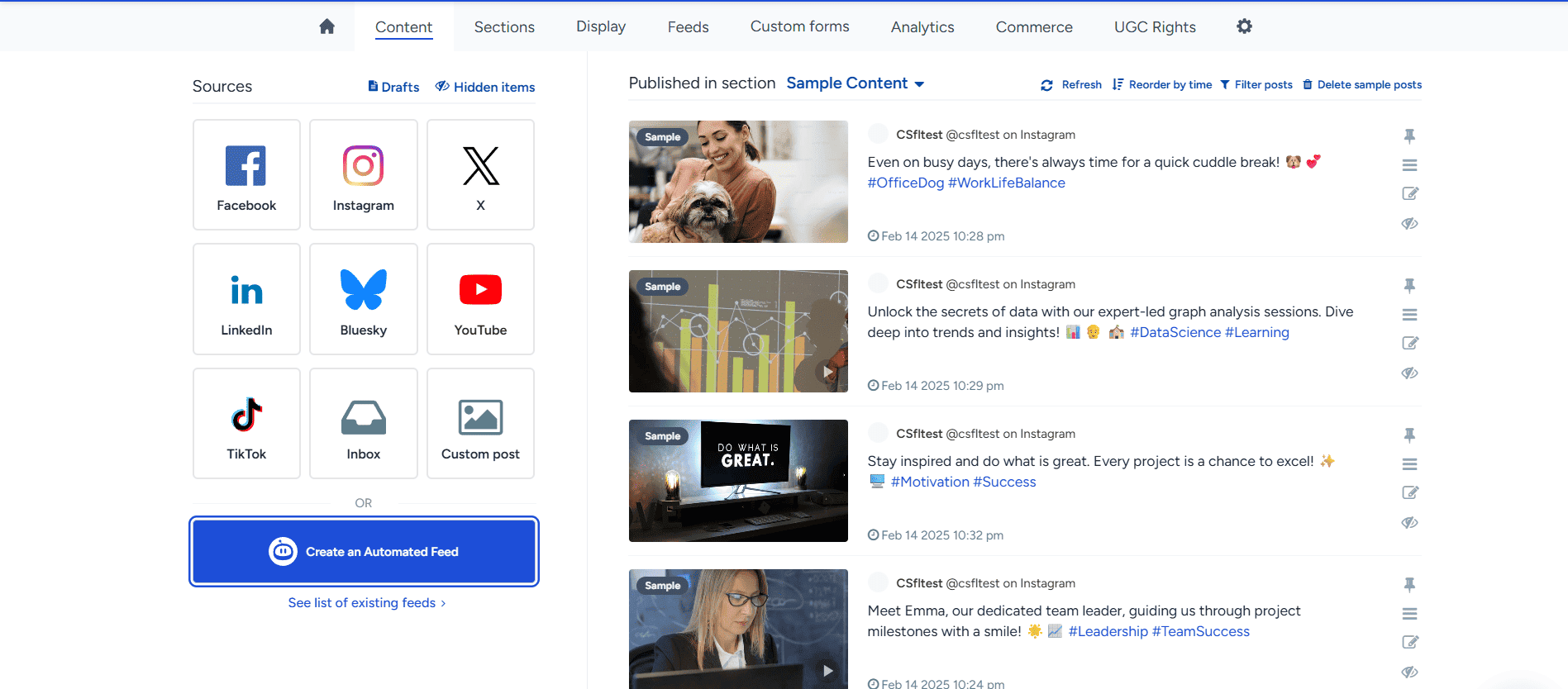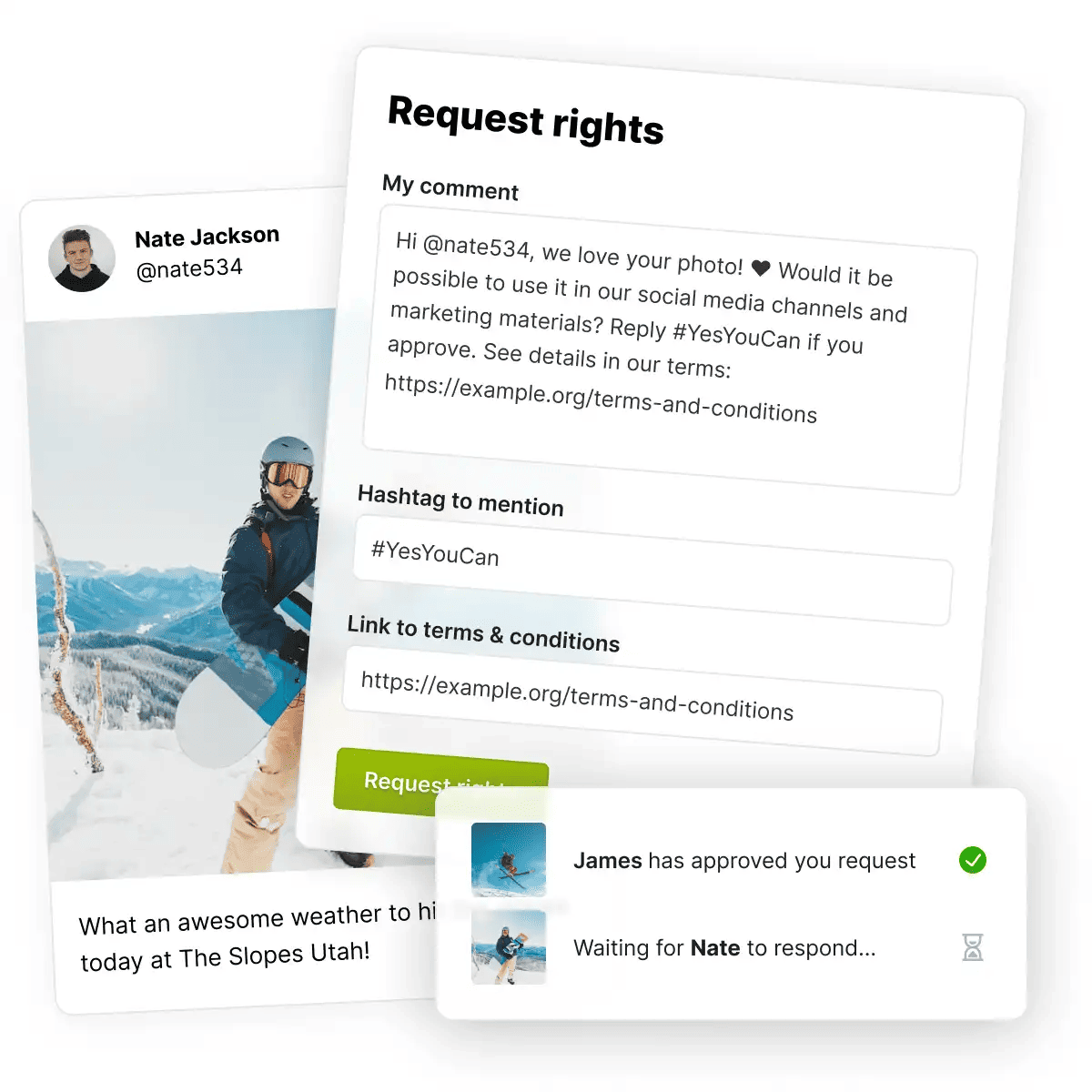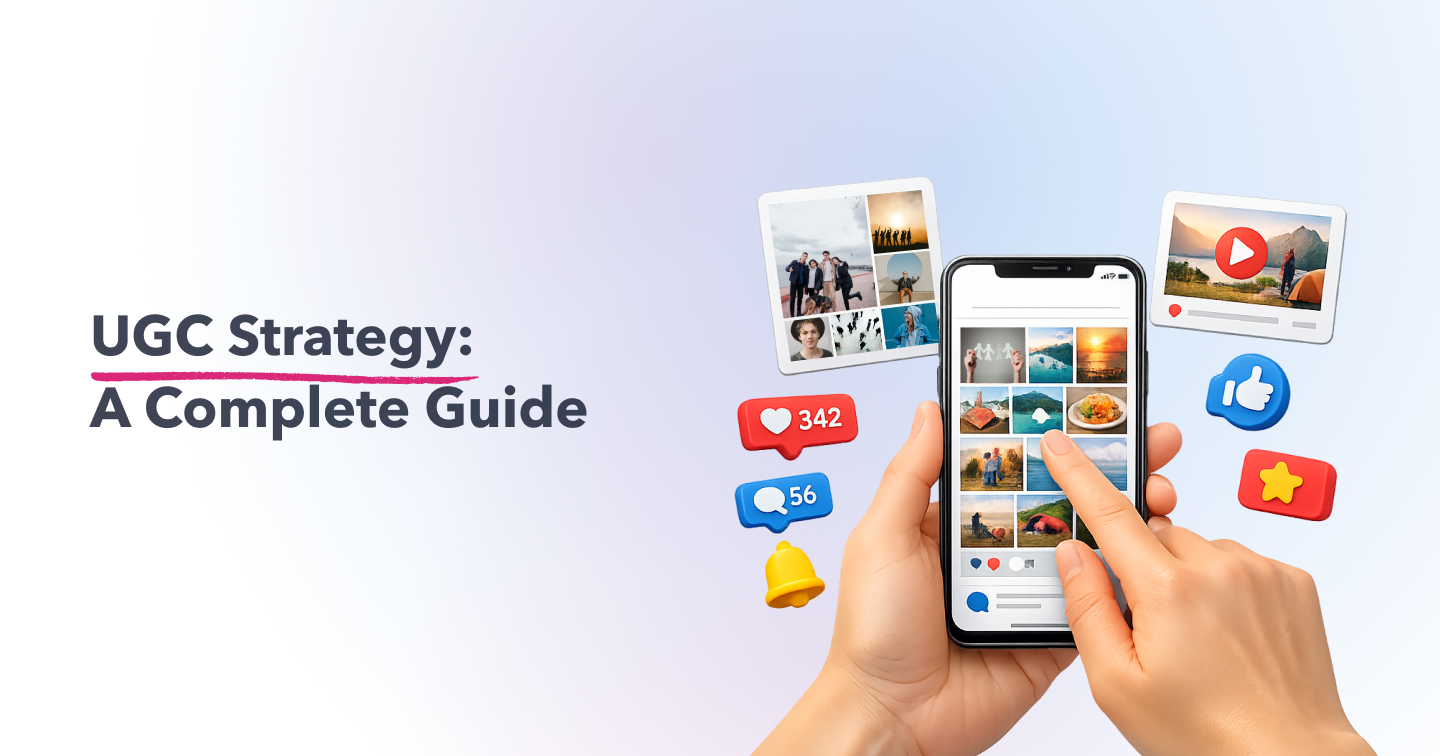Summary
- A well-planned UGC strategy turns customers into authentic brand advocates, building trust, social proof, and loyalty.
- UGC, when properly implemented, significantly increases engagement, conversion rates, and content efficiency compared to brand-created content.
- An effective UGC strategy requires clear sourcing, consent, moderation, integration (website, social, email, signage), and performance tracking.
- Combining UGC with a social wall or content aggregation tool simplifies management and enables scalable content workflows.
- UGC strategy isn’t one-size-fits-all; success depends on brand goals, audience, compliance (permissions/privacy), and ongoing refinement.
The online marketing space in 2026 is cluttered with generic corporate messaging and AI-generated slop, which is turning consumers away from traditional advertising. In such a landscape, authentic voices in your marketing, in the form of user-generated content (UGC), emerge as a clear game-changer, adding a layer of trust and a more human feel.
If you’re looking to implement UGC into your marketing playbook and don’t know where to start, we’ve got you covered. We’ll show you what a comprehensive UGC strategy looks like, some best practices, and how you can scale it sustainably.
What is UGC and why does it matter?
User-Generated Content refers to any content about your brand created by actual users, such as customers, community members, and fans. This usually occurs online through photos, videos, reviews, social media posts, testimonials, and comments.
Using UGC in your marketing can offer several benefits, such as:
Authenticity and trust: UGC provides genuine perspectives from real customers. This authenticity builds transparency and fosters trust.
Higher engagement & conversions: User-generated content tends to perform better because it resonates emotionally and prompts customers to take action.
Facilitates cost-effective content production: Instead of investing heavily in in-house content creation, brands can leverage UGC from their own customers. This drastically reduces the resources and cost of creating content.
Social Proof & Community Building: UGC acts as social proof, showing real people using and enjoying your products. That peer-driven endorsement is powerful; it nurtures loyalty and creates a community around your brand.
📕New to UGC marketing? Before implementing a UGC strategy, check out Flockler’s in-depth UGC guide, which includes real-life examples.
How to build a modern User Generated Content strategy
A modern user-generated content strategy serves as a framework for scalable UGC content sourcing, moderation, curation, integration, and optimization across channels. Here are our core tenets on how to build:
Step 1: Define Clear UGC Goals
Before you start collecting or encouraging content, define what you want to achieve with your UGC marketing. Determine if you aim to:
- Build brand awareness and social proof
- Increase site or social engagement
- Boost conversions, sales, sign-ups, leads
- Foster community loyalty and a sense of belonging
- Create a scalable, cost-efficient content pool
Having well-defined goals influences everything. It determines what content you request, where you encourage generation, how you incentivize contributions, and which metrics you'll use to track your success.
Step 2: Audit Existing Content & Community Assets
Before launching anything new, assess what you already have. If you’re an established brand, chances are you're already generating UGC organically. Go online and check out your brand reviews, social posts, comments, unboxing photos, customer feedback, or social media mentions.
- Collect all existing content: reviews, testimonials, feedback, social mentions, and community comments.
- Look through social media tags, hashtags, mentions, unboxing videos, lifestyle photos, usage images, and videos shared by customers.
- Audit your community channels, forums, social media groups, and customer feedback portals to gauge the kind of content being created.
This gives you a clear picture of what UGC you are generating and what's actually usable based on your corporate goals. If you find your UGC content inadequate, you can invest in marketing to raise awareness and set up channels to request UGC from your customers.
It also helps you understand which formats resonate most with your community and which social media platforms they use. Use this audit as the foundation for your UGC strategy.
Step 3: Source and generate Content Strategically
Once you have your available UGC, start collecting the following UGC content based on your goals:
Customer reviews & testimonials: Look for genuine feedback from buyers' honest, real-world experiences with your product or service. Try looking at websites that are known to show genuine reviews.
Social media posts: Gather organic content shared by customers on platforms such as Instagram, TikTok, Facebook, and X (Formerly Twitter) for B2C customers, and on LinkedIn for B2B customers.
Visual content: Keep a library of photos, unboxing shots, lifestyle images, usage photos, video reviews, and YouTube content, among others.
You can search for content using branded hashtags, brand mentions, and so on. To generate content, use marketing hashtag campaigns, online challenges, contests, community events, or incentives to prompt users to share their experiences.
Brands that actively encourage content through incentives and community-driven campaigns typically generate more and higher-quality UGC than those that passively wait for posts. This approach scales content creation without heavy production costs.
Step 4: Aggregate & Organize Content Centrally
As content volume grows, managing UGC manually across platforms becomes chaotic. The solution: centralize everything. You can use Flockler to simplify your content aggregation capabilities.

Flockler does this by:
- Collecting content from all sources, reviews, social posts, campaign submissions, and direct uploads into one unified content library
- Helps you tag and categorize assets by content type (photo, video, review), campaign, product, theme, or user demographics. This makes it easy to retrieve and reuse relevant content
- Track metadata: original source, submission date, consent status, creator info, usage history, crucial for compliance, tracking, and analysis
- Allowing you to create an automatically updating dynamic content wall that keeps content fresh and relevant
Without centralization, UGC becomes scattered across silos, diminishing its value and increasing the risk of duplication, mismanagement, or compliance issues.
Step 5: Obtain clear consent for UGC use

Using it responsibly is essential to safeguard trust and maintain brand integrity. You must
- Obtain explicit permission: Always ask users before reposting or reusing their content. Consent should be clear and documented.
- Define submission guidelines: Provide clear guidelines on acceptable content types and a standard for quality, tone, style, and brand alignment.
- Credit original creators: When publishing, give credit to the user. This builds goodwill, respects ownership, and encourages future contributions.
Flockler helps you do just this with its UGC right management platform, which makes it easy to request rights directly from any social media channel and upload them hassle-free.
Step 6: Strictly Moderate content based on clear brand guidelines

UGC can come in all forms and sizes, some good, some bad. Content moderation is key as:
- It ensures that only relevant, brand-appropriate content is displayed.
- Helps you comply with privacy or copyright norms
- Ensures you filter out spam, low-quality images, or anything that could harm brand image
While manual content moderation is not possible due to the volume of content on social media platforms, you can use Garde AI for enhanced content moderation capabilities.
Step 7: Integrate UGC across multiple marketing touchpoints
By embedding UGC across diverse touchpoints, you ensure that authenticity and social proof are present with maximum reach. Here's where you can present your content:
E-commerce product pages & reviews sections: Real user photos and reviews increase buyer confidence, reduce hesitation, and help prospects envision real-life use.
Website galleries & landing pages: Visual UGC lifestyle images, real-life usage fosters relatability, emotional engagement, and brand authenticity.
Email marketing & newsletters: Featuring UGC in emails boosts engagement and reinforces social proof among subscribers.
Social media channels & ads: Organic or paid posts with UGC often outperform traditional ads due to their authenticity and peer-driven appeal.
Digital signage: For brands and institutions with physical spaces, such as stores, events, pop-ups, schools, and so on, using UGC on digital signage or displays helps reinforce offline community and brand trust.

On Flockler, you can choose from different layouts such as grid, wall, carousel, and slideshow to optimize for each.
Step 8: Measure Performance, Analyze & Iterate
A UGC strategy requires ongoing evaluation and refinement. Key metrics to track:
Engagement metrics: Likes, shares, comments, time on page, interaction rates with UGC content.
Conversion metrics: Conversions, sales lift, leads, sign-ups, compare UGC-enhanced experiences vs. control pages without UGC.
Content-type performance: Understand which content formats and channels get you the most traction
Operational metrics: Understand the volume of UGC submissions, moderation turnaround, reuse rate, and content freshness.
Flockler allows you to track such metrics and gain insights with the analytics dashboard. You can use these insights to fine-tune your strategy: adjust content sourcing methods, refine moderation rules, and rotate content types.
This iteration ensures your UGC strategy remains effective, relevant, and aligned with brand goals.
Best Practices for Implementing a UGC Strategy
Implementing UGC at scale comes with challenges, but with the right approach, you can maximize benefits while minimizing risks:
- Avoid low-quality or irrelevant content: Set clear brand guidelines, communicate expectations, and moderate content before public display
- Prevent over-saturation or content fatigue: Balance UGC with brand-created content; rotate content types and avoid flooding channels with too much UGC at once
- Ensure legal compliance and permissions: Always get explicit consent, credit creators, and respect copyright, privacy, and regulatory requirements.
- Manage volume across channels: Use content aggregation tools and centralized workflows instead of manual handling across disparate platforms.
- Continuously measure and iterate: Don't treat UGC as a one-time campaign; treat it as an ongoing strategy. Collect data, refine workflows, retire stale content, and adapt to audience preferences.
By combining discipline, transparency, and structure, you can build a UGC program that's sustainable, scalable, and effective.
How Flockler Makes Scaling UGC Practical
Implementing all of the above manually can quickly become overwhelming, especially as your brand grows. That's why a platform that aggregates, curates, and manages UGC at scale is essential.
Flockler transforms UGC strategy from a "nice to have" to a core marketing infrastructure:
Centralized content collection and moderation: All UGC from reviews, social platforms, and campaign submissions lands in a unified dashboard. No more scattered spreadsheets or neglected mentions.
Consent & metadata tracking: Flockler helps you manage user permissions, track content origin and usage history, and ensure compliance with legal and privacy requirements.
Seamless embedding across channels: Once curated, UGC can be embedded on websites, in newsletters, in ads, in social posts, or even in digital signage, enabling cross-channel activation with minimal effort.
Scalable workflows: As content volume grows, Flockler helps you avoid manual bottlenecks, streamline publishing workflows, and maintain consistent quality.
Analytics & optimization: Track which content performs best, which channels drive most value, and which formats convert better, enabling data-driven decision making and continuous improvement.
If you're not yet leveraging UGC effectively, 2026 is the time to start. Build your strategy. Engage your community. Get started with Flockler’s 14-day free trial and see what happens when customers speak for you!
Here are comprehensive FAQs for the UGC Strategy guide:
FAQs
What is a UGC strategy, and why do I need one?
A UGC strategy is a systematic approach to collecting, managing, and deploying user-generated content across your marketing channels. You need one because UGC builds authenticity and trust that traditional advertising cannot match 88% of consumers trust user reviews as much as personal recommendations. A structured strategy ensures you consistently collect high-quality content, use it legally and effectively, and measure its impact on your business goals.
How do I get customers to create UGC for my brand?
Start by making it easy and rewarding. Use branded hashtags, run contests or challenges, offer incentives (discounts, shout-outs, feature opportunities), and directly ask customers after purchases or milestones. Brands that actively encourage content through community-driven campaigns generate significantly more and higher-quality UGC than those that wait passively. Make participation simple with clear instructions and show appreciation by featuring customer content prominently.
Do I need permission to use customer photos and posts from social media?
Yes, always. Even if the content is public, you should obtain explicit permission before reposting or using it in marketing. This protects you legally, respects creators' rights, and builds goodwill. Flockler's rights management platform simplifies this by allowing you to request permissions directly from any social media channel and document consent for compliance.
How do I ensure UGC aligns with my brand guidelines?
Establish clear submission guidelines that define acceptable content types, quality standards, tone, and style. Use moderation workflows to review content before it goes live, filtering out spam, low-quality images, off-brand content, or anything that could harm your brand image. Tools like Flockler with integrated moderation capabilities (including AI-powered options like Garde AI) help you maintain brand standards even at scale.
What types of UGC should I collect for my brand?
The most effective approach includes multiple types: customer reviews and testimonials for trust signals, social media posts for authenticity, visual content (photos, videos, unboxing shots) for relatability, and case studies for depth (especially in B2B). The mix depends on your industry, audience, and goals. Visual brands benefit most from photos and videos, while B2B companies often need detailed testimonials and success stories.
Where should I display UGC for maximum impact?
Display UGC across multiple touchpoints: e-commerce product pages to boost conversions, website galleries and landing pages for emotional engagement, email campaigns to reinforce social proof, social media channels and ads for peer-driven appeal, and digital signage in physical locations. By embedding UGC throughout the customer journey from discovery to purchase, you ensure authenticity is present at every decision point.







